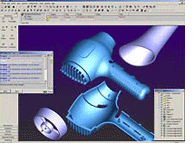 ImpactXoft, a startup in San Jose, Calif., was ready to introduce pathbreaking software to the crowded and rapidly changing market for digital product definition and collaborative product design. Players and prophets had been contributing new definitions of this market, along with matching acronyms, for over a year by the time ImpactXoft debuted the concept of Simultaneous Product Development in the spring of 2001. The company needed to define itself and its IX SPeeD technology quickly. The next step was to build on initial positive response from industry observers. Not only was ImpactXoft presenting next-generation software for digital product modeling – they were also proposing an entirely new approach to product development.
ImpactXoft, a startup in San Jose, Calif., was ready to introduce pathbreaking software to the crowded and rapidly changing market for digital product definition and collaborative product design. Players and prophets had been contributing new definitions of this market, along with matching acronyms, for over a year by the time ImpactXoft debuted the concept of Simultaneous Product Development in the spring of 2001. The company needed to define itself and its IX SPeeD technology quickly. The next step was to build on initial positive response from industry observers. Not only was ImpactXoft presenting next-generation software for digital product modeling – they were also proposing an entirely new approach to product development.
Parker Group tackled the challenge of educating the marketplace by writing a solid media kit for ImpactXoft. We coupled an extensive conceptual FAQ describing ImpactXoft technology and the company’s vision of Simultaneous Product Development with an editorial brief that traced recent changes in design collaboration trends. On a multicity tour that Parker Group arranged to coincide with the official launch of the software in the fall of 2001, the company’s CEO and CTO visited dozens of influential editors and analysts to present their ideas in person.
This strategic approach to education and outreach resulted in strong visibility for ImpactXoft. By the end of that year, the company had won a prestigious Technology of the Year Award from IndustryWeek, an Editor’s Choice Award from Cadence, and an Innovation Award from Computer Graphics World. News of the software launch was widely picked up, and Parker Group placed articles explaining ImpactXoft technology in Desktop Engineering, Injection Molding Magazine, Computer-Aided Engineering, and Appliance Manufacturer, among others.
To cement comprehension of ImpactXoft technology in the marketplace, Parker Group followed the launch of IX SPeeD by writing a white paper that explored the evolution of design collaboration and product modeling tools over the past few decades. Created for a number of different audiences — potential customers and partners, trade and business editors and journalists, and industry analysts — the paper defined new terms and explained the rise of parallel co-development as a strategy for engineering organizations in the Internet age. Print and online distribution of the paper forged a deeper appreciation of ImpactXoft’s vision for the future of global simultaneous product development and supported the company in its sales efforts.
